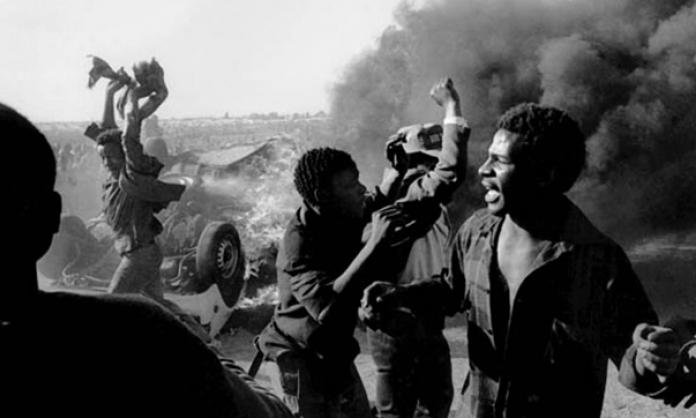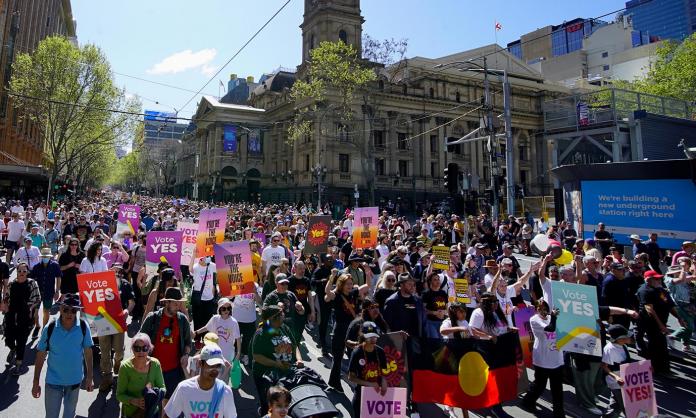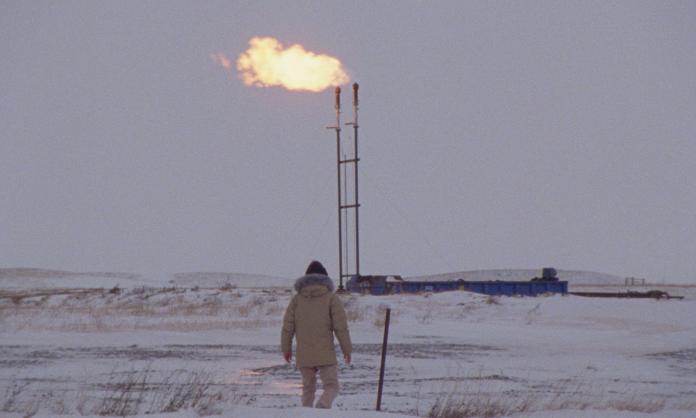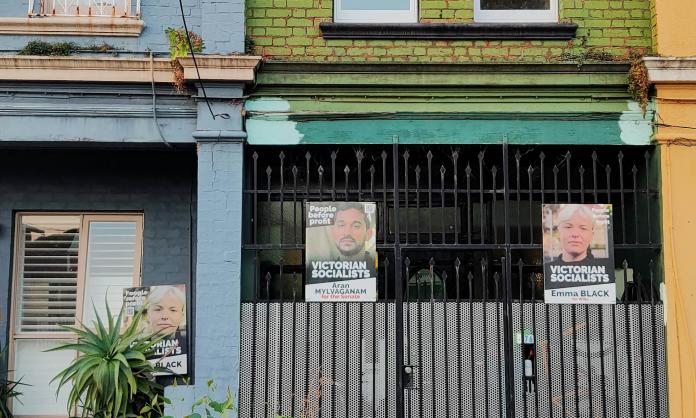It was 22 October 1977. The reactionary Queensland premier Joh Bjelke-Petersen had banned street marches to stymie the anti-uranium movement. Now, a rally of 3,500 had to decide how to respond. We attempted to subvert Petersen’s ban by walking along footpaths in small groups wearing smocks emblazoned with “Solar not nuclear” (placards were also banned). The cops were having none of it. Chaos and arrests ensued. After retreating to King George Square, we debated whether to engage in civil disobedience by marching illegally.
At the time, I was new to activism and had little way of judging the arguments. But it seemed to me, regardless of what respectable citizens like the clergy on the platform might think, that the socialists were right – we either marched illegally and risked arrest or we gave up a basic democratic right. We voted to march, and 418 of us ended up in police cells.
Since then, I’ve encountered debates about civil disobedience in just about every protest campaign or movement that I’ve been involved in. And it is never just the action of breaking a prohibitive law that is debated, but also the proposition that nonviolence should be an intrinsic principle of any political movement and should determine what civil disobedience is permissible.
The Brisbane Civil Liberties Campaign of 1977-79 accommodated a range of opinions and actions typical of genuine mass movements. We disrupted business as usual by marching and sitting down in busy streets and picketing the courts when arrestees appeared. “Civil disobedience” proponents emphasised nonviolence, accepting arrests, refusing to pay bail, fighting the charges and crowding the jails. However, it quickly became evident that the government was not hugely affected by these tactics. And on our side, only small numbers could realistically miss work or abandon family responsibilities repeatedly or for a long time while they were locked up.
The key question therefore became a political one: to win, how could the movement exert the necessary pressure on the government? Mass support was key. It was built eventually through a combination of highly visible acts of civil disobedience – often leading to mass arrests and fighting – backed up by grassroots campaigning on the streets and in workplaces. This involved visits to Labor Party branches, speaking to workers in their workplaces and at union meetings, negotiating with union officials to get them to endorse the rallies, speaking in high schools, holding neighbourhood information nights and mass postering and spray painting (which risked arrest and fines).
I attended hundreds of such activities. It was not the absence or otherwise of violence that decided attitudes, but politics. Hundreds of thousands of workers backed the campaign regardless of how much fighting they saw on the evening news. If you had a good argument, if you could link your demands to those of workers and the oppressed, you won their support. They could see that civil liberties weren’t an issue only for anti-uranium activists. Trade unionists were denied the right to strike in many situations and, along with Aboriginal activists and feminists, they were also prohibited from marching in the streets.
Coal miners in Collinsville, central Queensland, still take pride in the fact that every time we marched in Brisbane, they were on strike, marching locally. Thousands of waterside workers and seamen, building workers and many other unionists backed the campaign, striking, marching and donating money for bail and legal teams. At one of the last illegal marches in December 1978, most arrestees were blue collar workers. Mass strikes, constant agitation and disruption were the crucial factors that fractured the resolve of government backbenchers and even ministers. After 18 months, the government backed down.
Inevitably, the questions of how to win and what tactics are needed have emerged in the new climate movement. One of the most visible organisations declares: “Extinction Rebellion has nonviolence as one of its core principles, which is non-negotiable for everyone who wants to take action under the name of XR”. Its proponents claim that violence of any kind will alienate potential supporters. But there is scant evidence for this.
In Hong Kong for example, the increasing turn to rioting, burning buildings and fighting police after weeks of nonviolent passive resistance has, at the time of writing, not depleted the hundreds of thousands protesting – quite the opposite.
Some climate activists say that nonviolence works, citing as “proof” Erica Chenoweth and Maria J. Stephan’s Why Civil Resistance Works. The Strategic Logic of Nonviolent Conflict. But according to Chenoweth and Stephan’s criteria, 47 percent of “nonviolent” movements failed; and many of the “successes” were only partial. Hardly strong numbers to base an entire strategy on.
They cite the mass protests during 1989 in a range of countries in Stalinist Eastern Europe – during which people simply refused to leave the streets, forcing the fall of the regimes – as successful examples. But these struggles occurred at a particular historical moment, when the whole empire of the USSR was crumbling under the weight of its own economic, social and political crisis. With no way out for the elite, stepping down and coopting the reform leaders proved a safer bet than risking a more radical outcome. Nonviolent challenges to these same regimes in an earlier era, such as in Hungary in 1956, were drowned in blood. The difference is not explained by the tactics used by the protesters, whether nonviolent or otherwise. Rather, these earlier uprisings were confronted with still confident, powerful regimes.
Chenoweth and Stephan offer no explanation for these different outcomes. They decontextualise struggles so that tactics become the primary determinant of whether movements succeed or fail. They admit there is a serious problem with their approach when they write: “Labeling one campaign as ‘nonviolent’ and another as ‘violent’ is difficult. In many cases, both nonviolent and violent campaigns exist simultaneously ... Alternatively, some groups use both nonviolent and violent methods of resistance over the course of their existence”.
To neatly categorise the struggle against apartheid in South Africa as nonviolent, they only take account of the period from the early 1980s to when the African National Congress (ANC) formed government in May 1994. They admit that some elements of violence were employed by the movement, but overall it is accepted as nonviolent. But this diminishes a rich tradition of courageous resistance to the racist state stretching back eight decades before, which laid the basis for this last decade.
From the beginning of the century until 1994, the struggle involved a fusion of nonviolent strikes and township revolts with a range of sometimes extremely violent measures, especially against informers. Nelson Mandela blew up power stations as part of a campaign of terrorism, for instance. Strikers regularly fought, and sometimes killed, strike breakers of Inkatha, an organisation led by corrupt Black leaders of KwaZulu-Natal who collaborated with the regime. Young people threw rocks and stones at police, burned cars and destroyed property. They routinely threatened anyone who hesitated about joining stay-aways or strikes. They carried wooden guns on their shoulders and sang the songs of the soldiers of the armed wing of the ANC, the Umkhonto we Sizwe.
When I was there in 1992, I learnt to Toyi Toyi on marches. This is a celebration of the jogging by Umkhonto we Sizwe guerrillas in their physical training. I attended a mass funeral after a massacre, at which Chris Hani, a much loved anti-apartheid fighter, averted a full scale attack on the procession by security forces by negotiating for young militants to give up their hand grenades. At the grave sides, the prayers, mourning, singing and chanting were punctuated with gun shots. Socialists in the struggle did not necessarily condone all of this, but it was a widely accepted part of a movement that, by Chenoweth and Stephan’s standards, proved to be a success. To have refused to fight alongside those prepared to use tactics that went beyond nonviolence, just as in Hong Kong today, would be comparable to informing or scabbing.
**********
Civil disobedience will always play a major role in any mass, serious movement for progressive change. How can it be otherwise, surrounded as we are by repressive laws in even the most democratic states. But elevating nonviolence as a guiding principle of this struggle, on the expectation it will provide some guarantee of victory, can only be disorienting. Inevitably, at least sections of most mass movements have resorted to violence, or at least the threat of it, if only to defend themselves against the brutality of the state.
Many movements today held up as nonviolent were anything but. Often, their history is deliberately sanitised. The fight for Indian independence, led by Gandhi, involved widespread violence in mass riots, mutinies by soldiers and rebellions by millions of workers and the poor. The Suffragettes likewise broke windows, fought police and set bombs.
The political norms that prevail in most Western democracies, and even in some authoritarian states, mean that struggles usually begin by appealing for citizens to join peaceful protests. Other than in anti-fascist campaigns, in my 40 years of experience, it is rare for anyone to argue for a deliberate turn to violence. In this context, a fixation on nonviolence within an already nonviolent movement appears more like an attempt to impose a moral code on the movement, rather than an argument for the most effective tactics.
This might be of no consequence until the question arises of how a movement holding to this moralistic standpoint should respond to supporters or others who need solidarity who do use some violence. What if coal miners get the courage to strike to close a mine and then use force to keep scab labour from reopening it? Many organisations have failed this test: Amnesty International, to its eternal shame, refused any support for Nelson Mandela and others incarcerated by the brutal apartheid regime because he refused to denounce the armed struggle.
It is not theory but charlatanism to argue that the success or failure of any movement can be attributed solely to violence or nonviolence. The British Campaign for Nuclear Disarmament (CND) in the early 1960s was a genuinely nonviolent movement. The Committee of 100 organised passive civil disobedience involving tens of thousands. Thousands were arrested. But their principled nonviolence could not overcome the political weaknesses of the leadership, which was simply too conservative to mount the kind of revolutionary movement needed to halt the imperialist arms race.
From the riotous strikes of cotton mill women workers in the early industrial revolution in Britain to struggles for suffrage, defiance of dictatorships, campaigns against war and racism and for women’s rights, civil disobedience has time and again emboldened activists and won wider support. By disobeying unjust laws, millions have established the rights we take for granted. When it has been necessary to fight cops, scabs or fascists, that is what activists have done. Their struggles have risen and fallen, come and gone, failed or succeeded, not because of violence or nonviolence, but because of the political, economic and social context, the politics that dominated their movement and the sheer brutality of capitalist regimes. Learning from these experiences, in all their complexity, is essential if we are to meet the challenge of averting disastrous climate change today.











